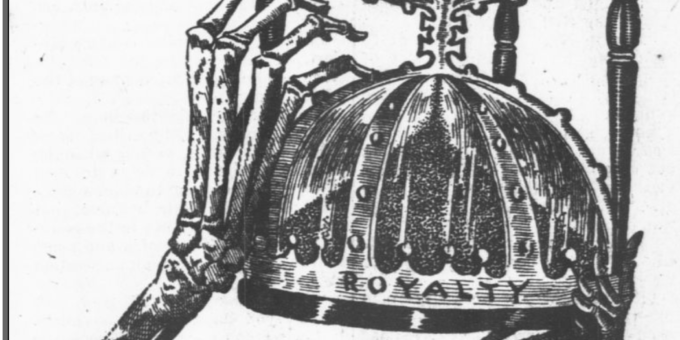
The article below, originally published in 1889, gives us insight into New York City’s morgue, the dead house. The article starts off slow, but gets increasingly detailed in its description of the morgue and Potter’s field.
Last Stop on the Road
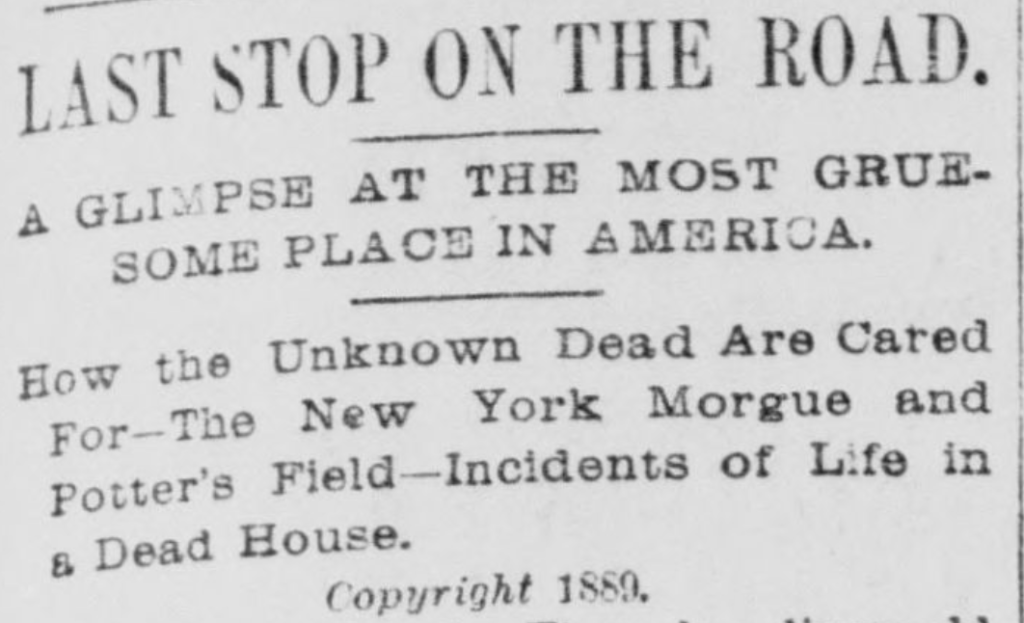
There is a dingy old building on a pier that runs out into the East River at the foot of Twenty-sixth Street, which is the last stop in many a life’s journey. One who has ever traveled in his dreams to the shore of time and looked at an imaginary ferry house, where the last boat for eternity was waiting for him, has probably seen a building very much like this one. The tides of the river flow under it, and there is another tide that passes through it day by day – a tide of mystery and wasted lives. It is undoubtedly the most gruesome spot this side of eternity and the Atlantic Ocean – this morgue of New York City where the unknown dead are allowed to rest for a time before they are hurried to Potter’s field and oblivion.
Two thousand people who fall in the battle of life every year without friends to remove them from the field are brought to this place.
The gray dawn was just breaking in the east, and had begun to sweep the shadows off the high walls of Bellevue Hospital when I entered the dead house.
The drip! drip! drip! of water falling on the white faces was the only sound that broke the solemn stillness. It is monotonous, but the dead mind it not, nor does the keeper who snoozes comfortably in the entrance. The river gurgles and flows under the morgue, and meanwhile the dead sleep on but the keeper is to be awakened.
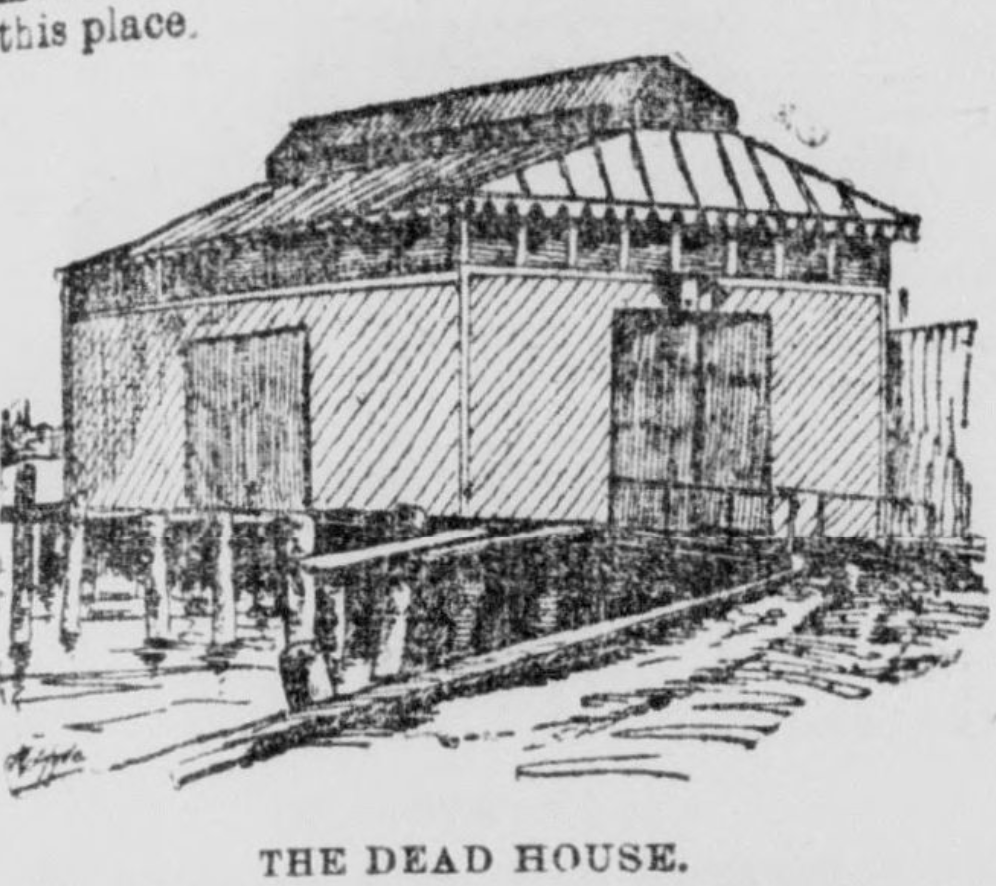
A heavy footfall arouses him, and he starts up. It is a hospital attache who has awakened him. There is a rough greeting.
“Another one I suppose?” the keeper says.
“Yes,” is the sententious reply, “another one! Went over the line a little after midnight.”
With these men, to die is to “go over the line.” They never speculate as to what follows “going over the line.” They leave that to less philosophical persons.
“Any friends?” asks the keeper again.
“None I guess that will keep him from going up the river,” is the reply, and the man jerks his finger significantly in the direction of Long Island Sound, which the keeper understands as being one result of “crossing the line.” The subject of their conversation has no friends who will prevent his burial in Potter’s field. But such a matter is so common that the keeper merely turns away to attend to some duty, and the hospital attache goes his way.
A few minutes later the water is dripping above another white face. It is the face of the man who “went over the line a little after midnight.”
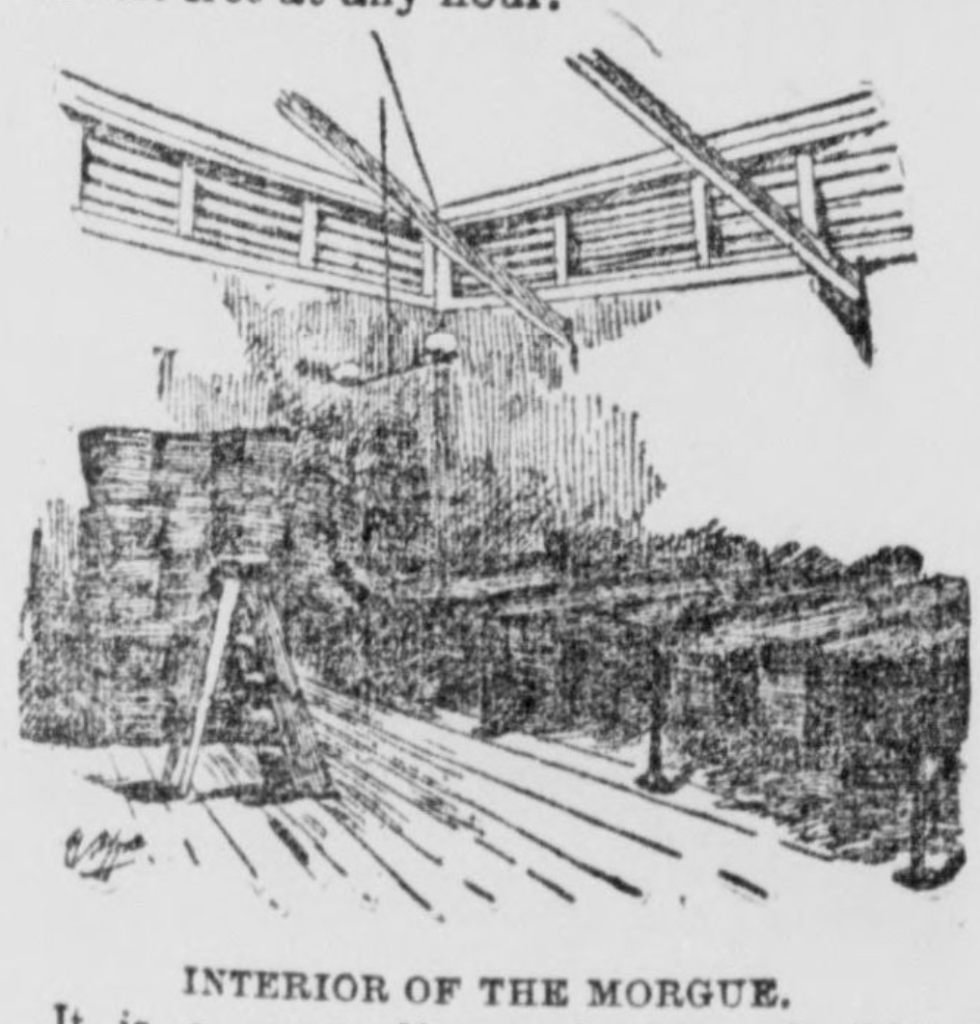
Such is an early morning scene on a dull day at the New York morgue. It is a prelude to what is to follow. For the New York morgue is a very busy place as a rule from daylight until midnight, and sometimes from daylight of one day until daylight of the next. It is a business like place too. There is a system and method about its management, and it is necessary that it should be conducted on business principles. Some 2,000 men, women, and children who “cross the line” pass through the morgue on their way to Potter’s field every year. More than that number who die on the streets, in Bellevue or some other place suddenly, are sent here, and are removed afterwards by friends. The morgue is filled with mysteries, some of which have been solved and some of which have not been.
The morgue is democratic. Men rich and distinguished have suddenly disappeared from the whirl of affairs in the great city of New York. They have afterwards been found in the city’s dead house whence they have been dragged from the river or the streets, lying side by side with some unknown pauper, who has died from drink, and who is on his way to Potter’s field. And it has never been known that the drip, drip, of the water above the marble slabs has made any distinction between the rich and the poor.
If anyone doubts that death is a leveler of almost all things let him visit the morgue. The morgue is not attractive, but it is the one place in New York where the pauper can rest free at any hour.
It is a very dingy looking building perched on piles out over the East River at the foot of East Twenty-sixth Street, near Bellevue Hospital. Everyone in New York knows a good deal about the morgue and Potter’s field, but as a matter of fact not one New Yorker in 1,000 ever sees either one or the other. Reporters for the daily papers, officials of various kinds and those looking for missing friends or relatives form the bulk of the visitors to the morgue. Potter’s field has few visitors of any kind. The charities commissioners of New York, who have charge of both places, have made it a rule to exclude mere morbid curiosity seekers, and a very good rule it is. And under its present management the New York morgue is somewhat ahead of those of London and not much behind those of Paris.
The day at the morgue, as has been outlined above, begins early.
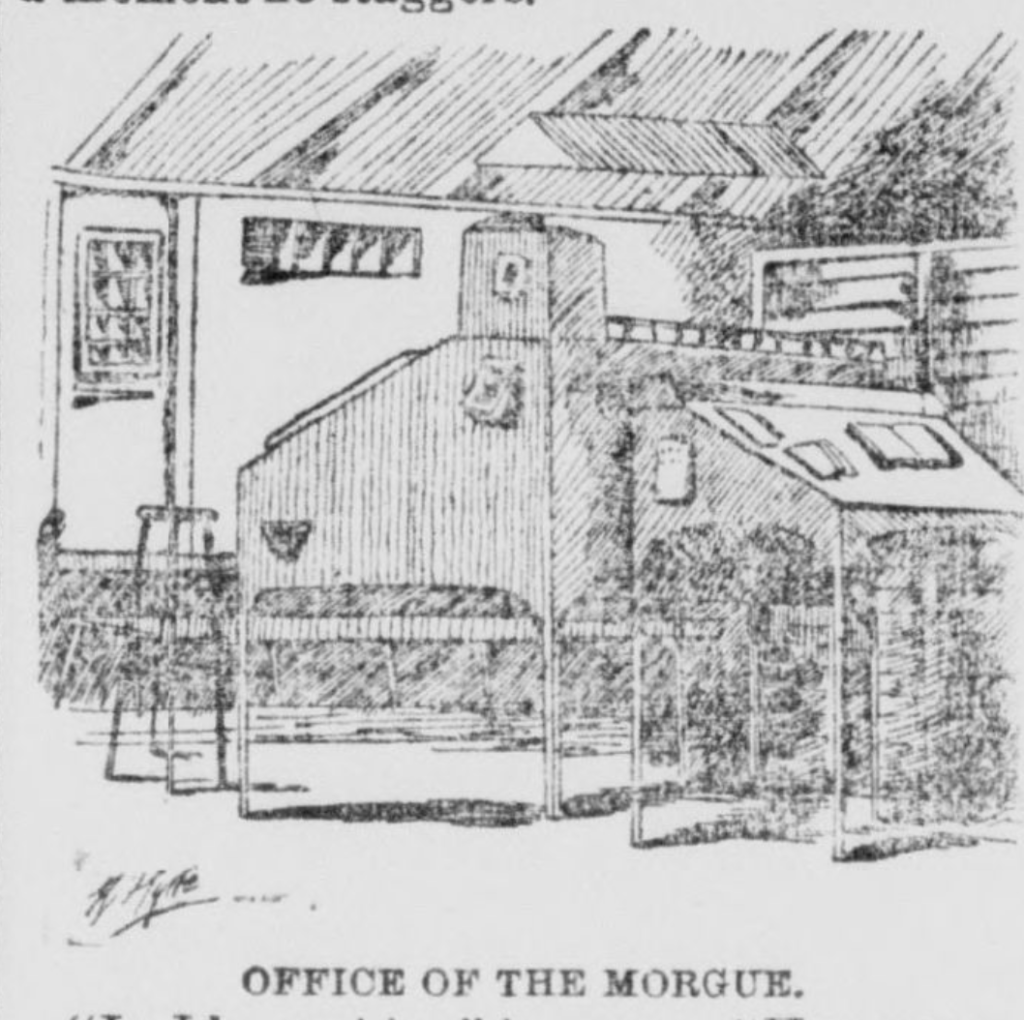
Bright and dapper, one of the coroners appears on the scene, almost the first caller. He has a case which must be viewed. It is only a man who has shot himself, and it does not take the coroner long to view him. Then the affable coroner shakes hands with Keeper Joe Forgarty, cracks a joke or two, smiles, draws on his gloves and departs for down town at a lively pace. The coroner is elected by a popular vote and must be cheerful even in the neighborhood of the morgue, for he lives in the district.
Then other visitors follow. First the reporters come. They stay but a little while. Then another body comes down from the hospital and is placed on a slab. Inside where the water is dripping, all out of tune with the flow of the tide underneath, are sights that not everyone would wish to behold.
Here lies an old man with gray hair and tangled beard. He is as yet unidentified and was found floating in the East River.
“I don’t know who he is,” remarks a morgue attache, “but I’m sure he’s somebody,” which remark seems to give him a great deal of comfort.
On another slab lies a young girl who must have been beautiful once. It is not necessary to ask why she is here. Her face and form show the cause and yet there is a something about her that causes one to look at her a second time. The bad has faded out of sight.
“Come on,” the morgue keeper says, “we have lots of them here.”
And so the round is made. A woman here, a man there; some from the river, some from the streets, some who have died in tenements and some who have died in hospitals.
In one corner is a fair haired baby less than a year old. A drunken father and a drunken mother and the rest is easily told or imagined.
The morning sun steals in and shines on the golden hair of the child and lights up its sweet, pale face, and even the rugged morgue employee is touched.
“It’s as though God smiled on it,” he says, in his own tough way, and rubbing his hard hand over his eyes he passes on, while the sun still shines lovingly on the dead child’s face.
But the morgue has early visitors, too. And very sad visitors they are as a rule.
A gray haired old woman stands patiently at the gate above the city’s dead house until she can see the good-hearted keeper of the morgue.
“Is she here?” she says in a simple sort of way when she sees him.
“Who?” is the fierce response. “Who but me daughter! I was told I’d find her here after a while! Is she here? Oh, tell me if she is,” and the woman’s voice becomes plaintive.
“Come in and see, my poor woman,” says the kindly keeper, and he leads her in very gently.
She scans every pale face that is exposed and turns back with a sad sigh.
“She’s not here yet, sir,” she says to the keeper, “but she’ll meet me here some time!”
Other visitors follow one after another.
A tall, slim-faced man calls to say he believes that a young man in whom he has taken an interest is here. He stalks through the morgue without a word, bestowing but a careless glance on all the bodies until he stops suddenly, where a handsome youth with a bullet-hole in his forehead lies. For a moment he staggers.
“I – I know him,” he says. “He was employed by me. The body shall be removed today.”
As the man stalks out the keeper says, “It’s his own son, but he won’t let on.” And the keeper was right.
So they drift along. A woman comes and recognizes a wayward son who has met a violent death. Wives come accompanied by undertakers’ wagons to take away the bodies of husbands which otherwise must go to Potter’s field. Men and women come for the hundredth time to look for bodies of loved ones whom they probably never will find.
A gray, bent old man calls to look at the body of his wife who died but a day ago, and, if the truth be told, partly of starvation. She is to be buried in Potter’s field today. The old man has neither friends nor money.
He looks long and loving upon the features of his dead wife and cried like a child. The keeper stands aside, for the keepers in the morgue are men.
“We’ve been together these fifty years,” the old man sobs, “and she was a good wife to me – she was indeed!”
“Mary,” he continues, as though speaking to one who heard, “to me you are the girl you were fifty years ago. There was none like you.”
In a trembling way the old man kisses the wan, worn face and comes out.
At the gate he says in a quiet, but dignified way, “Me and Mary’s been together these fifty years and we always planned to be laid together in the same grave, but Mary’s going to Potter’s field. God help me. I’m old, and weak, and poor but I’ll see my Mary again, and that I know.”
With this the old man moves on, and several of the men who have heard him, cough in a peculiarly husky manner.
And so the visitors come and go. And some days when a big fire or some great accident fills the morgue it is overrun with visitors and harrowing scenes are the rule. The mother recognizes her son among the dead. The wife finds her husband or the husband his wife. Then there are persons positively identified by reason of certain physical peculiarities who turn out after all not to be the persons they were thought to have been.
They tell at the morgue of many persons who have been identified as missing relatives by wealthy persons and who have been interred, under costly monument, with the result that the persons whom they represented afterwards turned up alive and well.
And then there are many great persons who pass through the morgue, are not identified and are buried in Potter’s field. A great master of masons suffered this fate many years ago, and the fact was not discovered until long after his internment. But the belongings of those who come to the morgue are carefully preserved to prevent this kind of an occurrence. But while visitors are coming and going to and from the morgue a boat is lying down at the dock below. Sometime before noon men are seen carrying long narrow boxes to the boat.
This boat is the hearse for New York’s dead paupers.
No millionaires on Fifth Avenue can afford one so large or so roomy. And the pauper gets the use of it for nothing. It is true it carries anything from a dozen to a score of paupers every trip. But then it is big enough to hold 200 paupers dead and three times that number or more living.
The pauper dead moves to his grave in an easy way in New York City. The officials do not
“Rattle his bones over the stones.”
On the contrary.
There are no secondhand hearses, with wind-broken horses. They group the East River, past Blackwell’s island, past Hell Gate – where Captain Kidd is said to have learned to place euchre, and where he lost his soul – past about where General Newton blew up a rock on which many a vessel split, and in which said Capt. Kidd is said to have been much interested, for it was said that in the early days there dwelt a witch near this very rock who was particularly friendly to the bold pirate and who had some sort of an evil bird, who made to every visitor of her this announcement:
“Enter mortal, if thou bear,
Priest nor mortal, book nor prayer.”
It may be easily imagined that there were few visitors at this particular place.
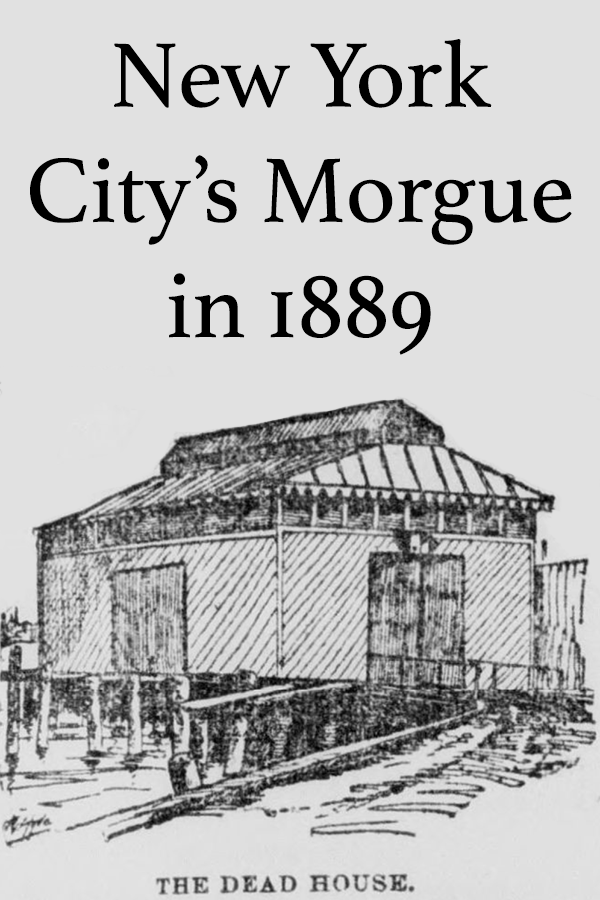
But the dead paupers drift up it as though it had never existed. And perhaps it never did.
Upon an island in Long Island Sound these pauper dead are landed. Paupers who are not fortunate enough to be dead take charge of the coffins. With one or two is someone who has a pass and who has come to see the dead interred. It is not a pleasant sight. They are buried by paupers from the workhouses, whose chief desire is to borrow tobacco and who show as little emotion as an ox in his stall does when consulted on the theology. Hart’s Island, where the unknown dead of New York rest, is a beautiful spot, or would be if it were not put to the uses it is. Yet, strange to say, the Long Island mariners, the most imaginative people in the world, have yet to report a ghost upon its shores, all of which goes to show that the mere fact that a man is not buried very deep does not prevent him from sleeping as deeply as he chooses.
But long after the boat has returned from Potter’s field, long after the day’s ordinary visitors have left the place of death, there is something left. It is the drip, drip on the dead faces in the morgue and the gurgle and splash of the water underneath goes on.
Source: The morning news. (Savannah, Ga.), 08 Feb. 1889.

